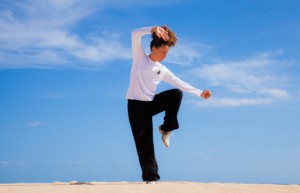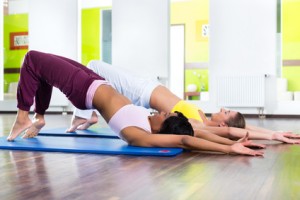A series of flowing movements based on Buddhist and Toaist teachings designed topromote spiritual and emotional well-being.
Further information:
The UK Tai Chi Association
PO Box 159
Bromley
Kent BR1 3XX. UK
Tel: ++ 44(0)208 289 5166
Fax: ++ 44(0)208 289 5166
email: uk-tai-chi@cheerful.com
www.ajc-taichi.co.uk
Is ancient Chinese art the key to managing modern-day stress?
By John Ding, Editor of Tai Chi and Alternative Health and founder of the John Ding Academy at Limehouse, London
Could the ancient Chinese art of Tai Chi be the key to relieving the stresses and strains of modern day living?
Whilst stress is an unavoidable consequence of modern day life, how we deal with the symptoms can, in some cases, mean the difference between life and death. Stress can manifest itself as headaches and insomnia, frequently raising blood pressure which can lead to an increased risk of coronary heart disease and stroke.
The economic impact is considerable too, with studies showing that between 75-90% of all visits to primary health care centres are due to stress-related problems. This is the number one cause of absenteeism from the workplace, costing £3.7billion a year in lost productivity and healthcare costs. Time magazine concurs, referring to stress as our leading health problem.
Numerous scientific studies support the theory that Tai Chis holistic approach to health could well be the answer for people seeking the path to a healthier and stress-free lifestyle and that it invigorates and strengthens the body from within. In Chinese medicine, the essence of good health is the requirement of yin and yang the concept of balance and harmony to create the smooth flow of vital energy, called chi, throughout the body.
John Ding is Founder and Tai Chi Instructor at the John Ding Academy. The health benefits of Tai Chi have been well documented and the majority of our students, ranging from busy housewives, City executives and taxidrivers, all enjoy Tai Chi as an antidote to hectic city life. It is easy to incorporate the principles into their daily routine and many students find everyday benefits such as improved posture, a toned and stronger body, a feeling of confidence and being at ease and creation of a more youthful appearance.
Some Tai Chi centres, such as the John Ding Academy, also offer business and management programmes to businesses. These enable the principles of Tai Chi to be brought to the workplace to counteract the stress that can be associated with working in a hectic environment. Companies who have benefited include Eastern Electricity, the Housing Association and Rydon Construction.
John Ding Academy
Limehouse Basin
5 Branch Road
Limehouse
London E14 7JU
2 mins walk from Limehouse DLR
020 7780 1818
www.johndingacademy.com
Biography: Master John Ding
Master (Sifu) John Ding, 6th generation Yang style Tai Chi Master, is the founder of the John Ding International Academy of Tai Chi Chuan, which has its headquarters in London (at the new John Ding Academy) and has approved instructors, teaching authentic Tai Chi all over the UK and Europe, including Germany, Spain, Ireland, Belgium, Portugal and Denmark.
He is the first disciple of the late Grandmaster Ip Tai Tak (5th generation of Yang style Tai Chi Chuan), who was himself the first disciple of Grandmaster Yang Sau Chung, 4th generation and Head of the Yang family.
Master Ding is one of the worlds leading authorities on Yang style Tai Chi Chuan and is one of the few teachers in the West able to demonstrate the higher aspects of the art and internal energy (Chi).
He teaches all over Europe and gives regular Tai Chi seminars at the two London centres. JDIATTC runs special courses for Age Concern and offers training programmes to introduce Tai Chi principles to management and business organisations.


